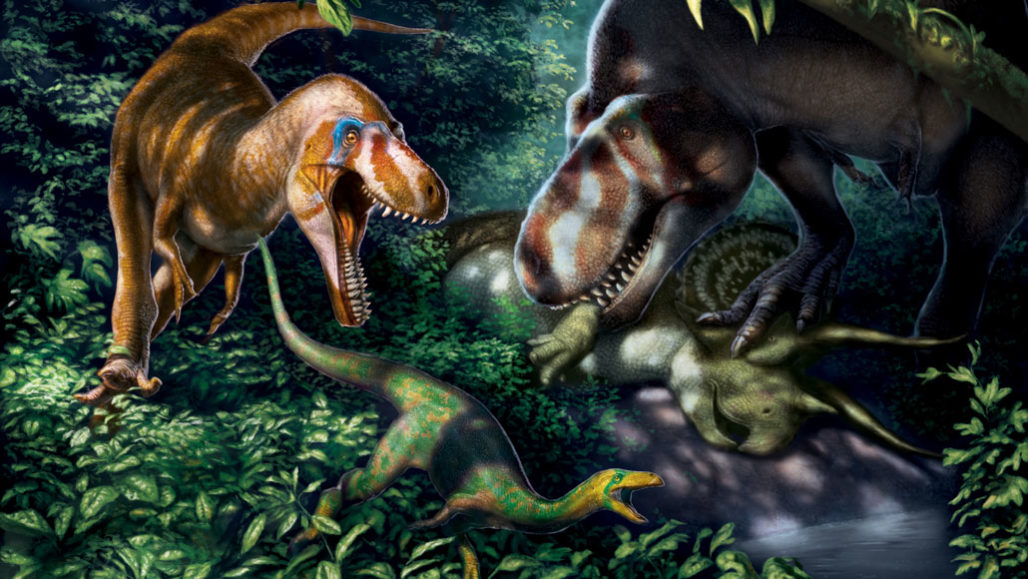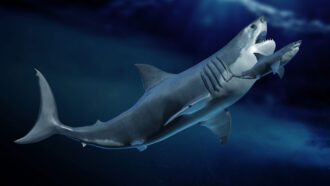Small T. rex ‘cousins’ may actually have been growing teens
Fossil analyses suggest that Nanotyrannus wasn’t a smaller relative of the famous dinosaur

Small-but-still-fearsome dinosaurs (depicted at left) were once thought to be mini cousins of Tyrannosaurus rex (right). In fact, they are likely to simply have been an adolescent T. rex, a new study suggests.
Julius T. Csotonyi
By Sid Perkins
The first fossils of Tyrannosaurus rex were discovered more than a century ago. About 40 years later, researchers unearthed a fossil skull similar to a T. rex. But it was smaller. It also had a few features that were somewhat different. Some were different enough for scientists to propose it came from a whole new species. Now, detailed analyses of related fossils show that those mini creatures may not be a different species after all — just teen versions of T. rex.
The new research shows something else, too. Those adolescent had different eating habits than their bone-crushing elders.
Scientists estimate that an adult T. rex measured more than 12 meters (39 feet) from its snout to the tip of its tail. It had teeth about the size and shape of bananas. And it likely tipped the scales at more than 8 metric tons (8.8 short tons). These fearsome meat-eaters may have lived 30 years or more. Fossils of Nanotyrannus suggest it would have been much smaller. Instead of the length of a school bus, it was only twice as long as a large horse, says Holly Woodward. She’s a paleohistologist (PAY-lee-oh-hiss-TAWL-oh-jist) at Oklahoma State University in Tulsa. (Histology is the study of the microscopic structure of tissues and their cells.)
For the past 15 years or so, debate has raged about whether Nanotyrannus indeed was a separate species. Its teeth were dagger-like, not banana-shaped, Woodward notes. But some other body features — once thought unique — have since showed up in other tyrannosaurs. So its status as a distinct species became less clear.
Woodward and her teammates decided to weigh in on the debate.
They analyzed leg bones from two alleged Nanotyrannus specimens. Researchers nicknamed these specimens “Jane” and “Petey.” The scientists sliced into each fossil’s femur and tibia. Those are the major weight-bearing bones of the upper and lower leg.
Jane is the smaller of the two. Cross sections of her leg bones revealed growth-ring–like features that suggest she was at least 13 years old. The same sort of features hint that Petey was at least 15 years old.
But other results were especially important, says Woodward. The number and orientation of blood vessels in the bones hinted that the bones were still growing vigorously. That’s an almost sure sign that Jane and Petey weren’t full grown, says Woodward. She and her colleagues reported their findings in the January 1 Science Advances.
“It’s clear that these creatures were not adults,” says Thomas R. Holtz Jr. He’s a vertebrate paleontologist at the University of Maryland in College Park. He did not take part in the new study. These animals, he notes, “were still growing and still changing” at the time they died.
Previous studies had suggested that teenage tyrannosaurs experienced a substantial growth spurt, Woodward says. And even though a young T. rex was the same species as an adult, it still might have behaved much differently, she notes. While juveniles like Jane and Petey were probably fleet-footed, an adult T. rex was a quick — if lumbering — behemoth. Plus, although a teen’s dagger-like teeth were strong enough to puncture the bones of its prey, it wouldn’t have been able to crush them as those of an adult T. rex could. So, youngsters and adults probably chased and ate different sorts of prey, Woodward concludes.
Holtz agrees. Because T. rex teens had a dramatically different lifestyle than adults, “they were functionally a different species.” That means they might have served a somewhat different role in their ecosystem than the adults. Nevertheless, he notes, they were likely still the dominant predator among dinos their size.







